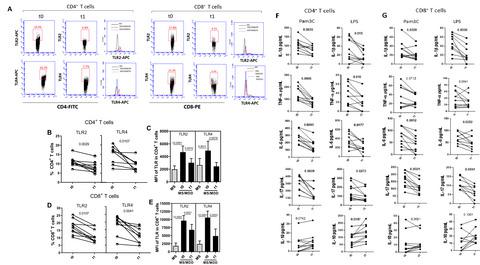当前位置:
X-MOL 学术
›
Immunology
›
论文详情
Our official English website, www.x-mol.net, welcomes your
feedback! (Note: you will need to create a separate account there.)
Selective serotonin reuptake inhibitor attenuates the hyperresponsiveness of TLR2+ and TLR4+ Th17/Tc17‐like cells in multiple sclerosis patients with major depression
Immunology ( IF 4.9 ) Pub Date : 2020-10-28 , DOI: 10.1111/imm.13281 Marisa C Sales 1, 2 , Taissa M Kasahara 1 , Priscila M Sacramento 1, 2 , Átila D Rossi 3 , Marcos Octávio S D Cafasso 1 , Hugo A A Oyamada 1, 2 , Joana Hygino 1, 4 , Fabianna Alvim 1 , Regis M Andrade 5 , Cláudia Cristina Vasconcelos 4 , Cleonice A M Bento 1, 4, 5
Immunology ( IF 4.9 ) Pub Date : 2020-10-28 , DOI: 10.1111/imm.13281 Marisa C Sales 1, 2 , Taissa M Kasahara 1 , Priscila M Sacramento 1, 2 , Átila D Rossi 3 , Marcos Octávio S D Cafasso 1 , Hugo A A Oyamada 1, 2 , Joana Hygino 1, 4 , Fabianna Alvim 1 , Regis M Andrade 5 , Cláudia Cristina Vasconcelos 4 , Cleonice A M Bento 1, 4, 5
Affiliation

|
Elevated frequency of Th17‐like cells expressing Toll‐like receptors (TLRs) has been recently associated with relapsing–remitting multiple sclerosis (MS) pathogenesis, a chronic inflammatory demyelinating autoimmune disease of the central nervous system. We aimed to investigate the impact of current major depressive disorder (MDD) on the behaviour of these cells following in vitro stimulation with TLR2, TLR4, TLR5 and TLR9 agonists. Here, the level of both cell proliferation and cytokine production related to Th17/Tc17 phenotypes in response to TLR2 (Pam3C) and TLR4 (LPS) ligands was significantly higher in CD4+ and CD8+ T‐cell cultures from MS/MDD patients when compared to non‐depressed patients. These cytokine levels were positively associated with neurological disabilities in patients. No difference for responsiveness to TLR5 (flagellin) and TLR9 (ODN) agonists was observed. LPS, but not Pam3C, induced significant IL‐10 release, mainly in patients without MDD. Interestingly, more intense expression of TLR2 and TLR4 on these cells was observed in MDD patients. Finally, in vitro addition of serotonin and treatment of MDD patients with selective serotonin reuptake inhibitors (SSRIs) reduced the production of Th17/Tc17‐related cytokines by CD4+ and CD8+ T cells in response to Pam3C and LPS. However, only SSRI therapy diminished the frequency and intensity of TLR2 and TLR4 expression on circulating CD4+ and CD8+ T cells. In summary, although preliminary, our findings suggest that adverse events that elevate circulating levels of TLR2 and TLR4 ligands can affect MS pathogenesis, particularly among depressed patients.
中文翻译:

选择性5-羟色胺再摄取抑制剂可减轻患有重度抑郁症的多发性硬化症患者的TLR2+和TLR4+ Th17/Tc17样细胞的高反应性
最近,表达 Toll 样受体 (TLR) 的 Th17 样细胞频率升高与复发缓解型多发性硬化症 (MS) 发病机制相关,这是一种中枢神经系统慢性炎症性脱髓鞘自身免疫性疾病。我们的目的是研究当前的重度抑郁症 (MDD) 对 TLR2、TLR4、TLR5 和 TLR9 激动剂体外刺激后这些细胞行为的影响。在这里,与来自 MS/MDD 患者的 CD4 +和 CD8 + T 细胞培养物相比,响应 TLR2 (Pam3C) 和 TLR4 (LPS) 配体的与 Th17/Tc17 表型相关的细胞增殖和细胞因子产生水平显着更高对于非抑郁症患者。这些细胞因子水平与患者的神经功能障碍呈正相关。未观察到对 TLR5(鞭毛蛋白)和 TLR9(ODN)激动剂的反应性差异。 LPS(而非 Pam3C)诱导显着的 IL-10 释放,主要发生在无 MDD 的患者中。有趣的是,在 MDD 患者中观察到这些细胞上 TLR2 和 TLR4 的表达更强烈。最后,体外添加血清素并用选择性血清素再摄取抑制剂(SSRIs)治疗 MDD 患者可减少 CD4 +和 CD8 + T 细胞对 Pam3C 和 LPS 的反应,产生 Th17/Tc17 相关细胞因子。然而,只有 SSRI 治疗才能降低循环 CD4 +和 CD8 + T 细胞上 TLR2 和 TLR4 表达的频率和强度。总之,虽然是初步的,但我们的研究结果表明,升高 TLR2 和 TLR4 配体循环水平的不良事件可能会影响 MS 发病机制,特别是在抑郁症患者中。
更新日期:2020-10-28
中文翻译:

选择性5-羟色胺再摄取抑制剂可减轻患有重度抑郁症的多发性硬化症患者的TLR2+和TLR4+ Th17/Tc17样细胞的高反应性
最近,表达 Toll 样受体 (TLR) 的 Th17 样细胞频率升高与复发缓解型多发性硬化症 (MS) 发病机制相关,这是一种中枢神经系统慢性炎症性脱髓鞘自身免疫性疾病。我们的目的是研究当前的重度抑郁症 (MDD) 对 TLR2、TLR4、TLR5 和 TLR9 激动剂体外刺激后这些细胞行为的影响。在这里,与来自 MS/MDD 患者的 CD4 +和 CD8 + T 细胞培养物相比,响应 TLR2 (Pam3C) 和 TLR4 (LPS) 配体的与 Th17/Tc17 表型相关的细胞增殖和细胞因子产生水平显着更高对于非抑郁症患者。这些细胞因子水平与患者的神经功能障碍呈正相关。未观察到对 TLR5(鞭毛蛋白)和 TLR9(ODN)激动剂的反应性差异。 LPS(而非 Pam3C)诱导显着的 IL-10 释放,主要发生在无 MDD 的患者中。有趣的是,在 MDD 患者中观察到这些细胞上 TLR2 和 TLR4 的表达更强烈。最后,体外添加血清素并用选择性血清素再摄取抑制剂(SSRIs)治疗 MDD 患者可减少 CD4 +和 CD8 + T 细胞对 Pam3C 和 LPS 的反应,产生 Th17/Tc17 相关细胞因子。然而,只有 SSRI 治疗才能降低循环 CD4 +和 CD8 + T 细胞上 TLR2 和 TLR4 表达的频率和强度。总之,虽然是初步的,但我们的研究结果表明,升高 TLR2 和 TLR4 配体循环水平的不良事件可能会影响 MS 发病机制,特别是在抑郁症患者中。










































 京公网安备 11010802027423号
京公网安备 11010802027423号